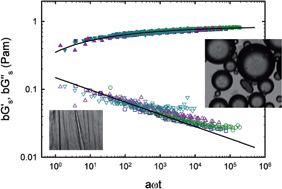Rough nanoparticles at the oil–water interfaces: their structure, rheology and applications
Abstract
A two dimensional suspension is used as a model system to study structural and dynamical responses of weakly attractive particles. An attractive glassy monolayer is produced by spreading carbon black particles at the interface, with attractive interactions between the particles stemming from lateral capillary forces caused by the surface roughness and the subsequent contact line undulations. By controlling the surface concentration, strong and elastic interfacial layers are formed which wrinkle reversibly upon compression. The rheological properties of the resulting monolayers can be described by the framework of the ‘soft glassy rheology’ model. For example, the effects of concentration for a given type of particle on the frequency dependence of the moduli can be scaled. Data for two types of particles with different surface roughness reveal the effect of the interaction strength on the elasticity. The monolayers are also observed to ‘age’ as a function of time, with the elasticity increasing over time. Based on the soft glassy rheology model, a master-curve can be obtained using a time–concentration superposition procedure, where the effect of interaction strength also can be scaled and evaluated indirectly.


 Please wait while we load your content...
Please wait while we load your content...